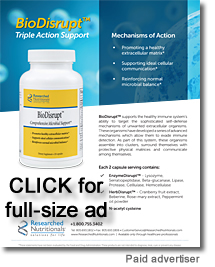Page 1, 2, 3, 4
Verification Testing for Quality Essential Oils
Companies that produce quality essential oils ensure impeccable sourcing of raw materials, optimal distillation techniques, verification of active compounds, testing for contaminants, efficient manufacturing procedures, and prioritizing sustainability. It is important to do your research on companies and find a supplier you trust for obtaining essential oils. I have made the effort to visit one company's farms and witness their harvesting, sourcing, verification tests, manufacturing, and distribution to validate their integrity and authenticity.
Due to the complexity of essential oils, your company should use more than one verification test. As I've made evident, an online GC/MS of CAs will only get you so far. Make sure you understand and can verify which quality control methods a manufacturer uses. Below is an example of testing methods used, based on a popular essential oil brand (Young Living Essential Oils):48
- Densitometry
- Viscometry
- Refractometry
- Polarimetry
- Inductively Coupled Plasma Mass Spectrometry (ICP-MS)
- Inductively Coupled Plasma-Atomic Optical Emission Spectrometry (ICP-OES)
- Gas Chromatography (GC)
- High Performance Liquid Chromatography (HPLC)
- Fourier Transform Infrared Spectroscopy
- Automated Micro-Enumeration
- Disintegration
- pH
- Microscopy
- Combustibility
- Flash Point
- Gas Chromatography Mass Spectrometry (GC/MS)
- Chiral Chromatography
- Isotope Ratio Mass Spectrometry (IRMS)48
Quantity and Dosage Considerations for Essential Oils
Most health care providers have the "five rights" for the administration of drugs drilled into their heads from medical training. These are the right patient, the right drug, the right time, the right dose, and the right route.49-51 This checklist may appear to make the administration of treatment less comprehensive and detailed than it truly is.52-54 Within these parameters, most practitioners will consider the following influences more thoroughly:52-59
- Mechanisms of action of the drug(s) and/or substance(s),
- Weight of the individual,
- Kidney and liver health,
- Most effective route,
- Allergies,
- The patient's age,52-54
- Relevant polymorphisms in biotransformation pathways,53
- The patient's current health conditions,56 and
- Nutrient-drug and other interactions.53,57-58
Metabolism and Biotransformation of Essential Oils: Taking a Walk Down CYP450 Lane
We now have an awareness that quality and factors of quantity, including consideration of biochemical individuality and drug metabolism, are important for prescribing the safest dose of any medicine, natural or otherwise.
I will now focus on the liver biotransformation of some common essential oils and their metabolites indicated for pain and digestion. I will also further explain synergism and how this needs to be considered for essential oils' metabolism and potential interactions. These aspects will help to guide the practitioner in deciphering how essential oils will be processed in each unique patient and their potential interactions with current supplements, nutraceuticals, and/or medications.
Chamomile Compounds
German chamomile (Matricaria recutita L.) herb and essential oil are both indicated for anxiety, irritation, inflammation, intestinal spasm/colic, and sedation.60-63 According to Alternative Medicine Review,61 and verified in several sources:60,62-63
German chamomile flowers contain 0.24- to 2.0-percent volatile oil that is blue in color. The two key constituents, (-)-alpha-bisabolol and chamazulene, account for 50-65 percent of total volatile oil content. Other components of the oil include (-)-alpha-bisabolol oxide A and B, (-)-alpha-bisabolone oxide A, spiroethers (cis- and trans- en-yn-dicycloether), sesquiterpenes (anthecotulid), cadinene, farnesene, furfural, spathulenol, and proazulene (matricarin and matricin). Chamazulene is formed from matricin during steam distillation of the oil. Yield varies depending on the origin and age of the flowers. European Pharmacopoeia recommends chamomile contain no less than 4 mL/kg of blue essential oil.61
It is important to know the species and chemotype of German chamomile oil when using it in clinical practice. Although similar, it cannot be blindly interchanged for Roman chamomile essential oil due to their different biochemical makeup. Notably, for those on anticoagulants, there are levels of coumarins in Roman chamomile oil. As stated in one review:
Roman chamomile contains up to 0.6% of sesquiterpene lactones of the germacranolide type, mainly nobilin and 3-epinobilin. Both α-bisabolol, bisabolol oxides A and B and chamazulene or azulenesse, farnesene and spiro-ether quiterpene lactones, glycosides, hydroxycoumarins, flavanoids (apigenin, luteolin, patuletin, and quercetin), coumarins (herniarin and umbelliferone), terpenoids, and mucilage are considered to be the major bio-active ingredients.62
The evidence for interactions with liver enzymes is not conclusive. One in vitro study of German chamomile tested its effects on four selected human cytochrome P450 enzymes (CYP1A2, CYP2C9, CYP2D6 and CYP3A4). The researchers' conclusions were based on increasing concentrations of major constituents incubated with recombinant CYP isoforms. They reported the following:
- CYP1A2 was most inhibited by chamazulene (IC50 = 4.41 microM), cis-spiroether (IC50 = 2.01 microM) and trans-spiroether (IC50 = 0.47 microM) and active towards CYP3A4.
- CYP2C9 and CYP2D6 were less inhibited, only chamazulene (IC50 = 1.06 microM) and alpha-bisabolol (IC50 = 2.18 microM) revealed a significant inhibition by the latter.64
There are several caveats with these conclusions that were discussed above. It is biased to base effects on isolated compounds in petri dishes to actions of the essential oil in humans.
Natural Medicines rates German chamomile's evidence for inhibition of liver enzymes as "D" level, an anecdotal and minor interaction. It does report a potential moderate interaction in combination with two medication classes, sedatives and oral contraceptives. Although this is also based on anecdotal evidence, it is rated "moderate" because the effect can result in a more severe impact.63
 Regarding safety, German chamomile herb is generally regarded as non-toxic60-63 and has evidence of beneficial use in human trials.63 Natural Medicines reported the following for German chamomile essential oil: "Six drops of oil infused with German chamomile flower has been safely applied nightly for up to 6 weeks in children 6-18 years-old (98621)." Regarding safety, German chamomile herb is generally regarded as non-toxic60-63 and has evidence of beneficial use in human trials.63 Natural Medicines reported the following for German chamomile essential oil: "Six drops of oil infused with German chamomile flower has been safely applied nightly for up to 6 weeks in children 6-18 years-old (98621)."
There is one report of a woman who was on warfarin and after taking chamomile herb concurrently experienced hemorrhaging. A review on this plant states that the small amounts of coumarin content present in German chamomile likely would not have contributed to this.61 This holds for the essential oil of Roman chamomile as well.61 It could be that the tea was Roman chamomile, which as previously stated does contain coumarins. This is not verifiable by the review.
A contraindication of using German chamomile is that those with allergies to the Asteraceae/Compositae family (ragweed, chrysanthemum, marigold, daisy, etc.) may experience cross-over hypersensitivity reactions to chamomile 60-64 and the essential oil.
Citrus Oils Constituents – First the Furanocoumarins
Citrus oils are common essential oils and have a high percentage of limonene content,65 a compound often used for relief of heartburn, dissolving cholesterol-containing gallstones, and as a chemopreventive.66 Components in the essential oil differ from citrus fruits, pulps, or juices. The volatiles make up 85-99% of total weight. These include limonene (a monoterpene), terpenoids, aldehyde, alcohols, esters, acids, and trace levels of sulfur and nitrogen compounds. Non-volatiles (PMF, furanocoumarin) make up the remaining amount of the essential oil.65
Due to the small amount of furanocoumarin present in the essential oil of citrus oils, the well-known interaction between grapefruit juice and the CYP34A enzyme is unlikely and less of a concern.65-68 I will still always suggest monitoring by the prescribing physician with any new intervention. I personally am especially vigilant if clients are of the "sensitive type," on several medications, herbs, and/or supplements, and/or has clinically relevant genetic variances.
Citrus Oils Constituents and Biotransformation
A thesis to determine the extent of inhibition of nine citrus essential oils on three CYP450 enzymes is often referenced to provide "evidence" of citrus oils impacting liver biotransformation. Although the author proved that limonene alone, the most abundant constituent did not have an influence on biotransformation, different citrus oils tested had differing outcomes in this in vitro study. The author concludes:
The results for CYP2E1 concluded that Citrus tangerine, tangerine, was the most potent inhibitor and inhibited through competitive inhibition. The results for CYP3A6 concluded that none of the nine citrus essential oils inhibited the activity of CYP3A6 at a good quality concentration. Lastly, the results for CYP2A6 concluded that both Citrus bergamia, bergamot, and Citrus aurantifolia, lime, were strong potent competitive inhibitors at low concentrations with a KI of 0.878 µg/mL and a KI of 0.045 µg/mL. The inhibition of CYP 2A6 has recently been identified as a possible therapeutic approach to smoking cessation, therefore giving significant importance to bergamot and lime oils and the compounds found in them.69
It's important to note that this thesis was done on rat liver microbiomes and the assays themselves may have altered the constituents in the essential oils.69 This petri dish study once again makes the accuracy in findings to essential oils and human metabolism very questionable.
Citrus Oils and Limonene Metabolism
Although biases do exist on isolated constituents' actions being extrapolated to an essential oil's effects, the mechanisms for metabolism of citrus oils in human trials are lacking. Therefore, it may be somewhat appropriate to consider how limonene undergoes biotransformation and is metabolized, given that citrus oils are mostly limonene by weight. The popularity of the limonene supplement has made the study of this in vivo and in human trials more readily accessible.66,70-76 According to a review in Examine:
Limonene is rapidly and almost wholly absorbed in the GI tract after ingestion, and then gets divided to various body tissues after first pass metabolism in the liver where it may be subject to metabolism into carveol metabolites or perillyl metabolites by CYP2C enzymes of which inter-species differences exist.71
After a 1.6g dose, between 52-83% of the dose is excreted in 48 hours and no build up of the compound is seen 21 days after cessation. The half-life of D-limonene in humans is estimated to be between 12 and 24 hours.
The primary metabolites of limonene in humans are perillic acid, dihydroperillic acid, and limonene-1,2-diol. These metabolites are glucuronidated by the liver and excreted via the urine.71
The supplement is generally considered safe in humans, though reports of toxicity exist in vitro and in vivo.66,70-71 The IARC monograph on limonene reports that rodents' metabolic processing of this compound are unlikely to be correlated to human effects:
Limonene is metabolized in humans and experimental animals to a variety of metabolites, including perillic acid and d-limonene-1,2-diol. Although deemed nephrotoxic in rats, this monograph reviewed in detail the difference between the metabolites interaction with proteins formed in rats versus with human urine protein content.70
Page 1, 2, 3, 4 |
![]()
![]()
![]()
![]()





